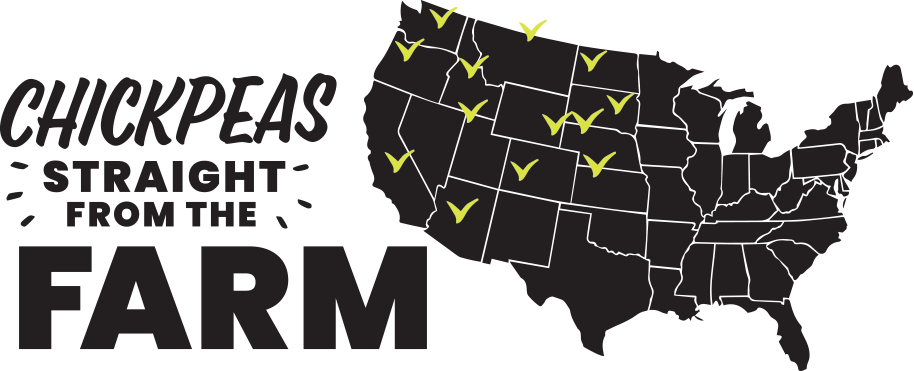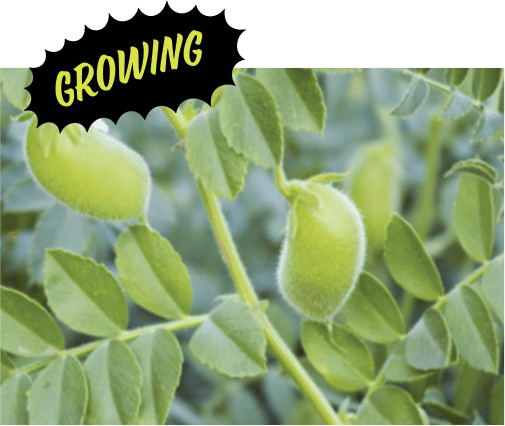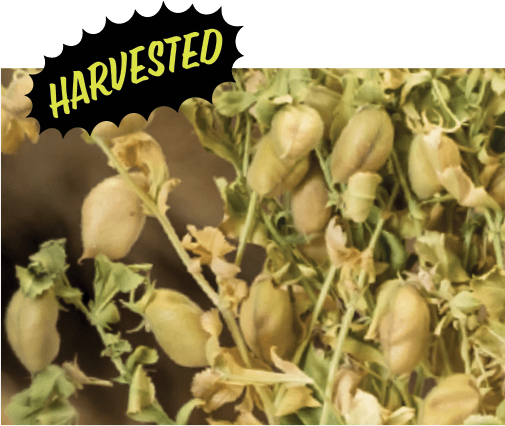Chickpeas

Affordable, delicious, and easy-to-prepare, U.S.-grown chickpeas – which come in either Kabuli (large) or Desi (small) varieties – are an excellent source of nutrients for all dietary preferences. In fact, the Dietary Guidelines for Americans categorize chickpeas (in addition to lentils, dry beans and peas) as both a vegetable and a protein, making them a nutrient-dense superfood.
In addition to being a go-to option for plant-based protein, chickpeas are packed with fiber, potassium and more, and are free from the top 9 allergens.
These tasty ingredients are plant-based superstars!



In addition to 7g of protein, chickpeas also contain 6g of fiber, 239mg potassium, 39mg of magnesium and 141mcg of folate per half-cup cooked serving. They’re also free from the top 9 allergens.
Nutrition Facts
PER HALF-CUP COOKED SERVING
| Chickpeas | |
| Calories | 130 |
| Total Fat | 2g |
| Sodium | 5.8mg |
| Carbs | 23g |
| Fiber | 6g |
| Protein | 7g |
| Iron | 2mg |
| Potassium | 239mg |
| Magnesium | 39mg |
| Folate | 141mcg |

Stovetop
1. Soak your chickpeas
Overnight: Use 3 cups of cold water for each cup of chickpeas, let stand for 8-24 hours and drain.
Quick Soak: Use 3 cups of cold water for each cup of chickpeas, boil 2 minutes, remove from heat, cover and let stand for one hour, drain.
2. Combine chickpeas + water, bring to a boil
For every cup of chickpeas, use 3 cups of water.
3. Simmer for 1.5-2 hours
Pressure Cooker / Instant Pot
1. Pre-soak beans and chickpeas before cooking
Using same method as above.
2. Add 1 cup of chickpeas + 1 cup of water to the pressure cooker
Cook on high for 7-12 minutes, let the pressure release naturally.
Note: Times may very slightly depending on the age and size of the pulse
Canned
1. Rinse chickpeas in cold water to lower the sodium content.
2. Toss chickpeas on top of salads, pastas, or mix in soups, chilis and more!

Consumers’ increased desire for plant-based protein sources, and more farmers adding chickpea crops to their rotations, has led to an increased number of products made with this pulse type.
To expand your chickpea horizons, head to your local grocery store and you’ll find a plethora of products including chickpeas – some more obvious than others: pastas, chips, dips, pizza crusts, frozen chickpeas, and of course, many hummus varieties. Yum!

Make egg-free snacking cookie dough with cooked or canned chickpeas
Blend chickpeas in smoothies for a creamy, high-protein addition
Substitute ½ of your ground chicken with cooked, smashed and seasoned chickpeas for a flexitarian dish
Roast chickpeas with your favorite seasonings, and use them as a replacement for croutons



Chickpea farmers abound in the U.S. – particularly in the Northern Plains, the Palouse and the Southwest.
Many other states are starting to grow more chickpeas and other pulses, as they play a key role in soil health and regenerative agriculture practices.
Planted in early spring and harvested in the fall, chickpeas must dry out completely in the field before harvest. By doing so, this allows chickpeas to be ready to eat in shelf-stable form as soon as they are harvested.



Chickpeas are good for your body and the earth. By converting nitrogen from the air through their roots and into the soil, chickpeas can reduce the need for synthetic nitrogen fertilizers, improving the environmental footprint of the chickpea plant as well as the footprint of future crops (like wheat or barley) that are grown on that same plot in subsequent crop rotations.
Not only that, but chickpeas, along with other pulse crops, require little water and land to produce. This contributes to a reduction in food waste due to their shelf-stability and plays an overall role in supporting sustainable agriculture.

In the U.S., we grow large cream-colored chickpeas (Kabuli) and small chickpeas (Desi), but chickpeas can also be black, green, red and brown.
Chickpeas are a cost-effective protein source, with 7g of protein per serving.
You can use chickpea water as a substitute for egg whites in baking – just whip up the residual liquid in a chickpea can to create aquafaba!
Chickpeas are one of the oldest foods – there is evidence that they were first cultivated in the Middle East in 7500 B.C.
Ground chickpeas have been used as a coffee substitute since the 18th century and are still commonly used as a caffeine-free alternative.